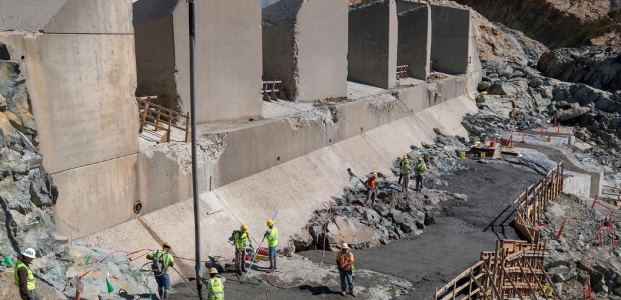
Oroville Dam's Partially Rebuilt Spillway May Be Used
The 2017/18 Lake Oroville Winter Operations Plan says the main spillway is to be used if the reservoir's elevation reaches 830 feet during the month of April. Current forecasts show inflows may raise the reservoir to near the 830-foot trigger elevation by the middle of next week. On April 3, the elevation was 794 feet.
Forecasts of storms this weekend in the Feather River basin may require the California Department of Water Resources to use Lake Oroville's main spillway, not yet completely rebuilt, this week or next week, the agency reported April 3. The spillway is a flood control outlet that is being rebuilt after erosion was caused by heavy rains in February 2017, which triggered an emergency evacuation of 188,000 downstream residents and necessitated extensive repairs.
The department subsequently created the 2017/18 Lake Oroville Winter Operations Plan to ensure public safety in the event of major storm events. The plan dictates more aggressive outflow from Hyatt Powerplant and potential use of the main spillway if the reservoir's elevation reaches 830 feet during the month of April; the report said the current forecasts show inflows may raise the reservoir to near the 830-foot trigger elevation by the middle of next week. On April 3, the elevation was 794 feet.
DWR began increasing outflows April 3 from Hyatt Powerplant to approximately 10,000 cfs in anticipation of the storms. The total capacity of outflows from Hyatt Powerplant is currently 12,500 cfs. If necessary, the agency said it also can use the River Valve Outlet System, which has an additional maximum outflow capacity of 4,000 cfs.
"DWR's objective for the year has been to minimize use of the main spillway while it is still under construction. However, because forecasts are uncertain, DWR is taking proactive steps such as early notification to downstream communities, regulatory agencies, and construction crews to prepare for possible use of the main spillway next week in the event the lake level reaches an elevation of 830 feet, even after increasing outflows through Hyatt Powerplant," its announcement said.
It said Phase I of the reconstruction of the main spillway was completed in November 2017 to handle outflows of 100,000 cfs. Phase II of construction on the main spillway will begin in May, depending on weather.
If the mail spillway is used this week or next, "inspectors will be closely monitoring the chute and flows," it said, explaining that because Phase I included repair and replacement of the upper chute and end of the chute with structural concrete, and construction of a temporary roller-compacted concrete section in the middle chute, a temporary section with a surface not as smooth as the structural concrete sections, the flow there may be more turbulent than in the upper chute, and additional wear may occur to the surface of the temporary section.